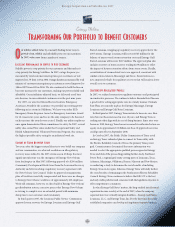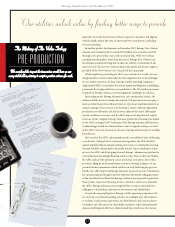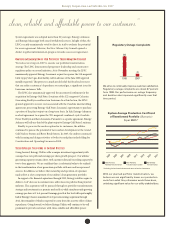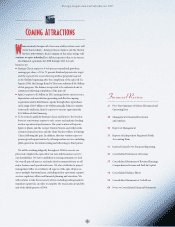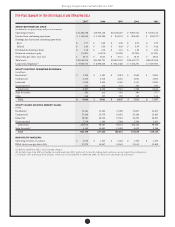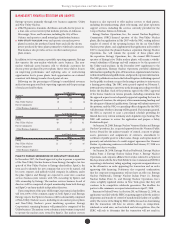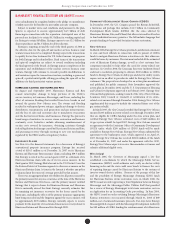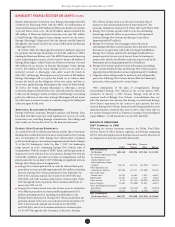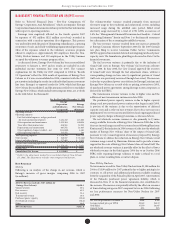Entergy 2007 Annual Report Download - page 23
Download and view the complete annual report
Please find page 23 of the 2007 Entergy annual report below. You can navigate through the pages in the report by either clicking on the pages listed below, or by using the keyword search tool below to find specific information within the annual report.
s humans, we created the climate change mess and as humans,
we have the potential within us to x it. Entergy believes the
debate on the science behind climate change is over and that
climate change is real. Going forward, ve key principles should guide
us as we – as a nation and an industry – develop a carbon policy to
address the climate change issue: take meaningful action now, use
market forces intelligently, be realistic about carbon prices, support
research and development and understand the social eects.
In 2006, the debate on climate change centered largely on whether
the science behind the issue was fact or ction. In our 2006 annual
report, we said the science behind climate change was real. We presented
opinions of well-respected climate change experts and we asked you
to form your own opinion and support action on the issue.
Today, the debate has shied dramatically. e science has now been
accepted as reality by most informed constituents. Now questions on
how to address the issue are taking center stage. Our view at Entergy
is there are ve guiding principles that we should follow in order to
develop a smart and eective carbon policy. ey are:
1. MEANINGFUL ACTION I S NEEDED N OW
Time is of the essence. To reduce future climate change impacts,
we must stabilize the growing concentration of greenhouse gases
in the atmosphere. Because of inertia in the system, greenhouse
gas concentrations will continue to rise even aer emissions have
been reduced. So, global greenhouse gas emissions rst must peak
and then decline thereaer, ultimately achieving stabilization. e
lower the stabilization level, the more quickly this peak and decline
in emissions will need to occur. Bottom line, the longer we wait, the
more dicult and costly it will be to achieve stabilization.
2. U SE MARKET FORCES INTELLIGENTLY
At present, there is no “silver bullet” to reduce carbon emissions at
low cost, and we need to face up to that. Carbon control will not be
cheap. We have to be as smart as possible about how we go about it,
so that we do not cripple the economy. Because it will be expensive,
we should rely on the most ecient method for resource allocation
and that is the market.
ere are two main forms of market-based greenhouse gas
regulation – a cap-and-trade system or a carbon tax. Cap-and-trade
limits greenhouse gas emissions at a dened level and tradable allowances
to emit are either freely allocated or auctioned o at an allowance
price set by the market. A carbon tax is levied on emitters based on
the amount of greenhouse gases they emit.
Entergy supports a cap-and-trade plan as it provides impetus for
companies to seek cleaner technologies and provides a revenue stream
for research and development investment in clean generation. Under
any cap-and-trade system implemented to reduce greenhouse gas
emissions, allowances should not be fully allocated. Selling at least
some allowances is essential in order to generate a revenue stream to
fund investment in necessary R&D and to help mitigate the regressive
impact of a carbon policy on low-income households.
Using market forces intelligently also means looking at the whole
picture. According to the 2007 U.S. Greenhouse Gas Inventory Report,
the electric sector emitted 2.38 billion metric tons of CO2 in 2005,
a third of total U.S. greenhouse gas emissions and only 5 percent of
the world total. e electric sector by itself cannot achieve the global
greenhouse gas emission reductions required for stabilization targets.
So it’s important not only to look at the cost, benets, eciency and
equity of the U.S. carbon policy, but also to consider how the policy
will interact with international policy. Bottom line, we need a market-
based approach with the broadest possible reach.
3. BE R EALISTIC ABOUT CARBON PRICES
We must be prepared for, and willing to accept, signicant carbon
prices that are high enough to encourage clean generating
technologies to enter the market. If we are lucky, under a cap-and-
trade model, CO2 allowance prices will not be more than $50 per
ton – but they could go higher. Whether we are lucky or not depends
principally on successful development of coal retrot technology.
Eighty percent of the U.S. electric sector’s CO2 emissions are from
existing coal plants. ere is presently no cost-eective technology for
post-combustion capture from conventional coal plants and experts
tell us that secure, long-term geologic storage of CO2 emissions is 10
years away. We need clean coal as a part of our future energy mix. For
that to happen, we need a carbon price that allows carbon capture
and storage to become a viable option. Unless and until we have that
technology, the only way to achieve the emission reductions needed
to meet stabilization targets would be a carbon price high enough to
induce the retirement of conventional coal plants. Our analysis also
shows that it would take a carbon price greater than $70 per ton to
achieve this outcome. is is not an acceptable outcome. Clean coal
needs to be part of our secure energy future. A cap-and-trade policy
that allows a price ceiling to rise to $50 per ton over a 10-year period
will stimulate innovation and help bring cost-eective, clean
Guiding Principles for a Carbon Policy
Entergy Environmental
climate change is real. Going forward, ve key principles should guide
A
Entergy Corporation and Subsidiaries 2007
21




